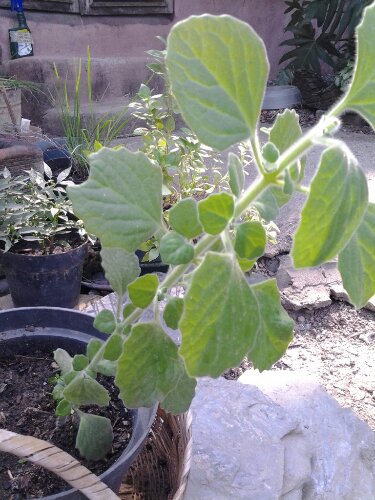When in the Patzcuaro area of Michoacan, Mexico, with my cousins last month, we visited the lakeside town of Tzintzuntzan with its old churches set in an ancient olive grove and its crafts market replete with straw Christmas decorations, baskets, painted pottery, and miscellanea.
Outside the gates of the church sat an elderly local woman enthusiastically hawking an array of small pots and bags of herb and flower seedlings in which were included rosemary and thyme, which I’d been looking for. I’d attempted growing them at our home by the sea in Zihuatanejo previously but without great luck–perhaps due to the heat or salt air; nevertheless, I wanted to give them another try.

Patzcuaro streets
The woman had a couple of rosemary plants, and I picked out the one that to me looked the healthiest but that also had a little sprig of some other plant growing out of it. When the woman saw me looking at that other plant, she was quick to point out that I was getting a freebee if I purchased that one; she wasn’t going to charge me extra for its presence in the mix. She said the plant was medicinal and good for chest and head congestion.
I expressed my appreciation for her generosity (besides, she’d already gone down in price from $20 pesos per plant to $10) and asked her what the plant was. She pronounced a weird name that sounded neither Purepecha nor Nahuatl, and certainly wasn’t Spanish. It sounded like “Wah-poo-roo,” with emphasis on the last syllable. I asked her again, and again she said, “Wahpooroo,” seeming to find it difficult to get her own mouth around the word, almost as if she were chewing it. She motioned to me to pinch off a leaf and smell it. It reminded me of menthol, but no, that wasn’t quite it.
As I sniffed, I pondered the name, repeating it to myself and looking expectantly at the woman, hoping to understand, somehow, what it was. Wahpooroo, wahpooroo . . . Suddenly I realized what she was saying and what this plant was: This was the VapoRub® plant!# Of course! Wahpooroo! Camphor! It was a real eureka-wahoo-wahpooroo moment, that was for sure. The incredible example of how language gets distorted almost made me laugh out loud, but I checked myself before the guffaw erupted, not wanting to make the seller think I was making fun of her. I did grin widely, though, and nodded happily to her that, yes, I did know what she was talking about and knew exactly what the plant was!
The camphor plant actually grows well in these climes and so is fairly common; in Spanish it is usually called alcanfor. I can imagine some tourist walking by the Tzintzuntzan vendor’s market spread, stooping to smell a leaf of the herb, and exclaiming, “Wow, this smells just like Vicks VapoRub®!” while the woman astutely files the name away in her mental herbal folklore database, thinking that now she can explain to tourists exactly what that plant is in their own language!

Camphor Plant
Once back home in Zihuatanejo, I transplanted the rosemary, thyme, and camphor into their own containers. The camphor has shot up tremendously from the two-inch sprig it originally was, and it seems very happy in the heat and humidity. The rosemary and thyme–well, they are plodding along and I’m hoping both will survive. They both have produced new growth–although neither is growing quite as wildly as the camphor. Both smell beautiful when the fresh leaves are crushed between the fingers and taste even better when used in cooking. I can only hope that they are happy enough to keep growing during the rest of the year. I know the camphor will.
By the way, neither the camphor plant (Ocimum kilimanscharicum), also known as camphor basil, nor the camphor laurel tree (cinnamomum camphora) should be used internally; the oil or leaves can be added to water and the steam used as an inhalant for lung and nose congestion, but neither oil nor leaves should ever be ingested or taken as a tea. Since camphor is an insect repellent (it’s the active ingredient in moth balls), I’m going to try using some of the crushed leaves in areas where ants and other insects abound around our house to see if it has any kind of deterrent effect.
# VapoRub® is a topical ointment manufactured by Vicks (Procter & Gamble). Its principal active ingredient is camphor.